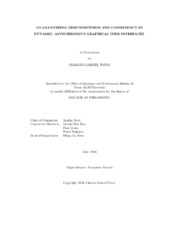| dc.contributor.advisor | Järvi, Jaakko | |
| dc.creator | Foust, Charles Gabriel | |
| dc.date.accessioned | 2016-07-08T15:06:17Z | |
| dc.date.available | 2016-07-08T15:06:17Z | |
| dc.date.created | 2016-05 | |
| dc.date.issued | 2016-01-25 | |
| dc.date.submitted | May 2016 | |
| dc.identifier.uri | https://hdl.handle.net/1969.1/156821 | |
| dc.description.abstract | This dissertation proposes a programming model for Graphical User Interfaces (GUIs) that relieves the programmer of a difficult and error-prone task: orchestrating concurrent responses to events to ensure data dependencies are always enforced correctly. In this programming model, rather than defining program responses to events, the programmer defines the data dependencies that exist in the GUI and the methods by which those dependencies may be enforced – a run-time system uses this specification to generate responses to events. The approach gives the following guarantee: the same sequence of events produces the same results, regardless of the timing of those events. The dissertation demonstrates the benefits of the proposed programming model with implementations of several example user interfaces.
At the core of this programming model is a data structure known as a property model. A property model composes responses to individual events into a single reactive program that runs asynchronously. The program's results are used to update the GUI. The program is constructed in a manner that respects all data dependencies, thereby guaranteeing that results are consistent regardless of the length of time taken by individual responses. The core reactive program may be extended with features that support additional functionality, such as access to prior variable values, optional data dependencies, and identifying unused variables. The dissertation defines the semantics of the construction and execution of this reactive program formally.
The dissertation shows how property models may be defined as a composition of reusable components. This is essential for modeling GUIs whose structures change in response to user events by the addition or removal of components. Components can contain data and dependencies as well as templates that describe how dependencies arise from composition with other components. Furthermore, templates can be written for arrays of components to define dependencies that arise among them.
One key task of the property model is planning by which methods dependencies will be enforced. The dissertation describes how a specialized planner can be constructed that is able to create a plan for a specific property model. This specialized planner is essentially a Deterministic Finite-state Automaton (DFA), and can be orders of magnitude faster than a general-purpose planner. | en |
| dc.format.mimetype | application/pdf | |
| dc.language.iso | en | |
| dc.subject | graphical user interfaces | en |
| dc.subject | asynchronous programming | en |
| dc.subject | reactive programming | en |
| dc.subject | dataflow constraint systems | en |
| dc.title | Guaranteeing Responsiveness and Consistency in Dynamic, Asynchronous Graphical User Interfaces | en |
| dc.type | Thesis | en |
| thesis.degree.department | Computer Science and Engineering | en |
| thesis.degree.discipline | Computer Science | en |
| thesis.degree.grantor | Texas A & M University | en |
| thesis.degree.name | Doctor of Philosophy | en |
| thesis.degree.level | Doctoral | en |
| dc.contributor.committeeMember | Dos Reis, Gabriel | |
| dc.contributor.committeeMember | Gratz, Paul | |
| dc.contributor.committeeMember | Shipman, Frank | |
| dc.type.material | text | en |
| dc.date.updated | 2016-07-08T15:06:17Z | |
| local.etdauthor.orcid | 0000-0002-4574-4666 | |


